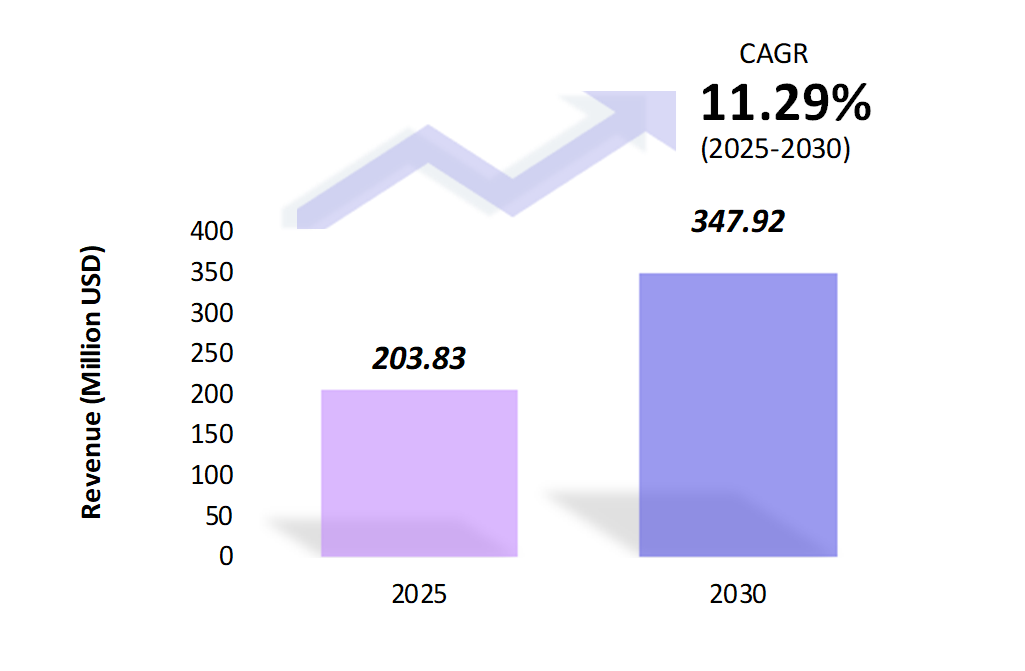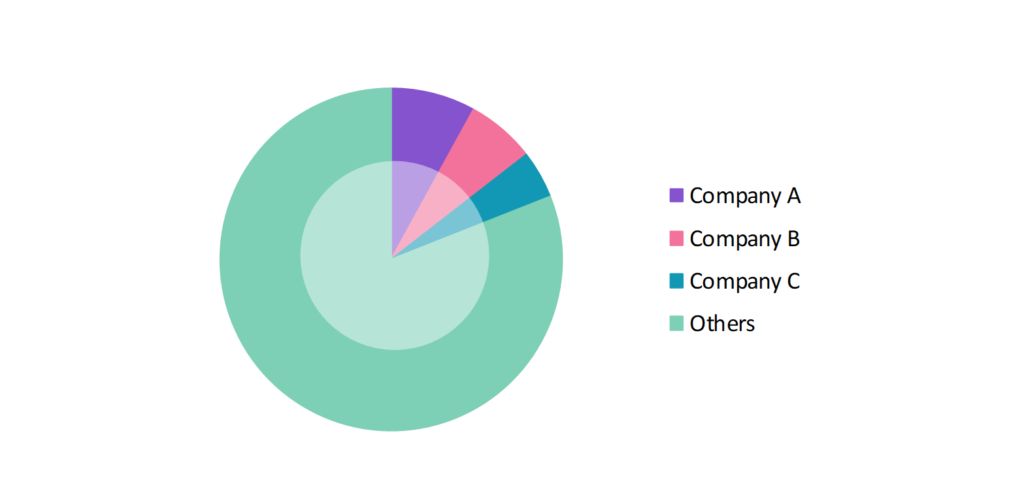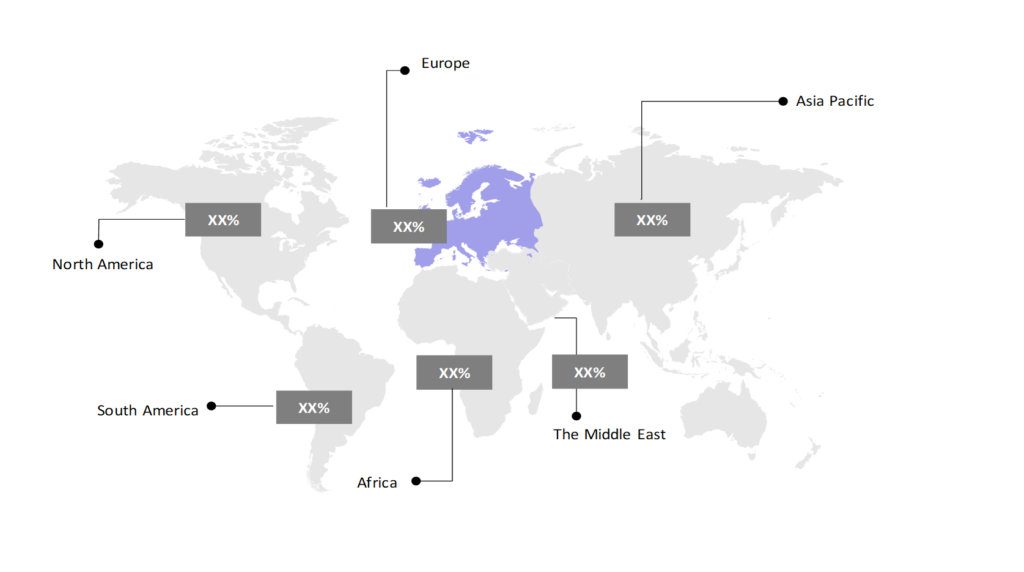Organic Deodorant Market Analysis: Growth, Size, Share & Future Trends (2024-2029)
The market report provided a comprehensive analysis segmented by Type (Roll Ons, Sticks/Creams, Sprays); by Distribution Channel (Supermarkets/Hypermarkets, Convenience Stores, Online); by Geography (North America, South America, Asia Pacific, Europe, The Middle East, Africa).
Outlook

- The organic deodorant market is estimated to be at USD 203.83 Mn in 2025 and is anticipated to reach USD 347.92 Mn in 2030.
- The organic deodorant market is registering a CAGR of 11.29% during the forecast period 2025-2030.
- The organic deodorant market is witnessing steady growth as consumer demand for natural and sustainable personal care products rises. Increasing awareness of health concerns related to synthetic chemicals and growing preferences for eco-friendly options are encouraging consumers to switch to organic alternatives.
Request a free sample.
Ecosystem

- The participants in the global organic deodorant industry are always developing their strategies to preserve a competitive advantage.
- These companies primarily use acquisitions, research & developments, partnerships, and technological launches.
- Several important entities in the organic deodorant market include Unilever Plc; Laverana Digital GmbH & Co. KG; Lavanila; Speick Naturkosmetik GmbH & Co. KG; Weleda AG; and others.
Ask for customization.
Findings
| Attributes | Values |
|---|---|
| Historical Period | 2019-2023 |
| Base Year | 2024 |
| Forecast Period | 2025-2030 |
| Market Size (2025) | USD 203.83 Mn |
| Market Size (2030) | USD 347.92 Mn |
| Growth Rate | 11.29% CAGR from 2025 to 2030 |
| Key Segments | Type (Roll Ons, Sticks/Creams, Sprays); Distribution Channel (Supermarkets/Hypermarkets, Convenience Stores, Online); Geography (North America, South America, Asia Pacific, Europe, The Middle East, Africa) |
| Key Vendors | Unilever Plc; Laverana Digital GmbH & Co. KG; Lavanila; Speick Naturkosmetik GmbH & Co. KG; Weleda AG |
| Key Countries | The US; Canada; Mexico; Brazil; Argentina; Chile; China; India; Japan; The UK; Germany; France; UAE; Saudi Arabia; Egypt; South Africa |
| Largest Market | Europe |
Get a free quote.
Trends
- Emergence of Eco-Friendly Packaging: Many organic deodorant brands adopt sustainable packaging solutions to align with environmentally conscious consumer preferences. In 2023, brands like Schmidt’s and Native introduced recyclable and biodegradable packaging, aiming to reduce plastic waste and appeal to eco-conscious customers.
- CBD-Infused Deodorants: The infusion of CBD in organic deodorants is gaining emphasis due to its anti-inflammatory properties and calming effects on the skin. In 2023, companies such as Malin+Goetz introduced CBD-infused deodorants, providing an innovative solution for sensitive skin and adding a new dimension to product differentiation.
- Emphasis on Clean and Transparent Ingredient Labels: As consumers become more health-conscious, transparency in ingredient sourcing and formulations has gained significant importance. Many scrutinize product labels to avoid harmful additives, prompting brands to disclose detailed information about their ingredients and production processes. This shift reflects a growing emphasis on cleaner, more ethical products.
Speak to analyst.
Catalysts
- Increasing Consumer Awareness on Health Risks of Chemicals: Concerns over synthetic chemicals in conventional deodorants, such as parabens and aluminum compounds, drive consumers towards organic alternatives. This shift is evident in the rising sales of organic brands like Tom’s of Maine, which reported a significant increase in 2023 following a heightened public focus on clean personal care products.
- Rise of Online Retail and E-commerce Platforms: The availability of organic deodorants on e-commerce platforms is driving their global reach, allowing consumers worldwide to access these products more easily. This shift highlights the role of online retail in expanding market access and boosting brand visibility in the growing organic personal care sector.
- Influence of Celebrity Endorsements and Social Media Marketing: Celebrity endorsements and influencer marketing have become powerful tools in promoting organic deodorants, as they help bridge the gap between brands and consumers. By leveraging the credibility and reach of well-known figures, these campaigns build trust and create a sense of authenticity around the product. Influencers, particularly in the wellness and beauty spaces, are able to showcase the benefits of organic options, sparking interest among their followers and driving consumer adoption.
Inquire before buying.
Restraints
- High Cost of Organic Ingredients: The use of natural ingredients in organic deodorants significantly raises production costs compared to conventional deodorants. Essential oils and plant-based extracts often come at a premium, making organic deodorants relatively expensive, which could limit market growth in cost-sensitive regions.
- Shorter Shelf Life of Organic Products: A significant challenge in the organic deodorant market is the lack of synthetic preservatives, which results in a shorter shelf life for these products. This creates logistical difficulties for brands, as they must manage higher production and storage costs to ensure product freshness. The shorter shelf life can also lead to increased risks of product waste and inventory management complexities.
- Regulatory and Certification Barriers: Organic and natural certification standards vary globally, leading to inconsistent regulations and certification challenges. In 2023, Brands like Green Tidings faced hurdles while expanding to new markets due to stringent organic labeling regulations, underscoring the need for alignment in international standards.
Personalize this research.
Hotspot

Explore purchase options.
Table of Contents
| 1. Introduction 1.1. Research Methodology 1.2. Scope of the Study 2. Market Overview / Executive Summary 2.1. Global Organic Deodorant Market (2019 – 2023) 2.2. Global Organic Deodorant Market (2024 – 2030) 3. Market Segmentation 3.1. Global Organic Deodorant Market by Type 3.1.1. Roll Ons 3.1.2. Sticks/Creams 3.1.3. Sprays 3.2. Global Organic Deodorant Market by Distribution Channel 3.2.1. Supermarkets/Hypermarkets 3.2.2. Convenience Stores 3.2.3. Online 4. Regional Segmentation 4.1. North America 4.1.1. The US 4.1.2. Canada 4.1.3. Mexico 4.2. South America 4.2.1. Brazil 4.2.2. Argentina 4.2.3. Chile 4.2.4. Rest of South America 4.3. Asia Pacific 4.3.1. China 4.3.2. India 4.3.3. Japan 4.3.4. Rest of Asia Pacific 4.4. Europe 4.4.1. The UK 4.4.2. Germany 4.4.3. France 4.4.4. Rest of Europe 4.5. The Middle East 4.5.1. UAE 4.5.2. Saudi Arabia 4.5.3. Rest of the Middle East 4.6. Africa 4.6.1. Egypt 4.6.2. South Africa 4.6.3. Rest of Africa 5. Value Chain Analysis of the Global Organic Deodorant Market 6. Porter Five Forces Analysis 6.1. Threats of New Entrants 6.2. Threats of Substitutes 6.3. Bargaining Power of Buyers 6.4. Bargaining Power of Suppliers 6.5. Competition in the Industry 7. Trends, Drivers and Challenges Analysis 7.1. Market Trends 7.1.1. Market Trend 1 7.1.2. Market Trend 2 7.1.3. Market Trend 3 7.2. Market Drivers 7.2.1. Market Driver 1 7.2.2. Market Driver 2 7.2.3. Market Driver 3 7.3. Market Challenges 7.3.1. Market Challenge 1 7.3.2. Market Challenge 2 7.3.3. Market Challenge 3 8. Opportunities Analysis 8.1. Market Opportunity 1 8.2. Market Opportunity 2 8.3. Market Opportunity 3 9. Competitive Landscape 9.1. Unilever Plc 9.2. Laverana Digital GmbH & Co. KG 9.3. Lavanila 9.4. Speick Naturkosmetik GmbH & Co. KG 9.5. Weleda AG 9.6. Company 6 9.7. Company 7 9.8. Company 8 9.9. Company 9 9.10. Company 10 |
Know the research methodology.
Organic Deodorant Market – FAQs
1. What is the current size of the organic deodorant market?
Ans. In 2025, the organic deodorant market size is USD 203.83 Mn.
2. Who are the major vendors in the organic deodorant market?
Ans. The major vendors in the organic deodorant market are Unilever Plc; Laverana Digital GmbH & Co. KG; Lavanila; Speick Naturkosmetik GmbH & Co. KG; Weleda AG.
3. Which segments are covered under the organic deodorant market segments analysis?
Ans. The organic deodorant market report offers in-depth insights into Type, Distribution Channel, and Geography.
